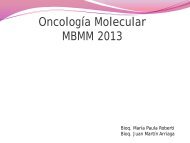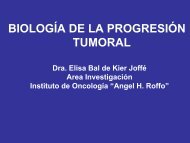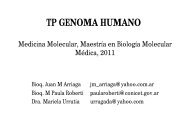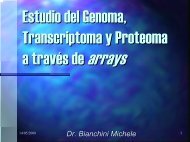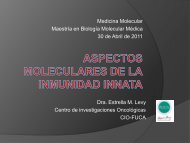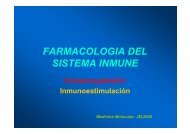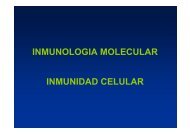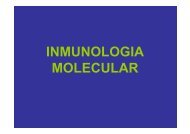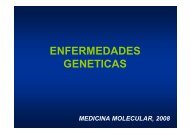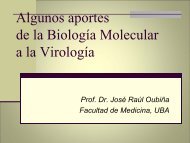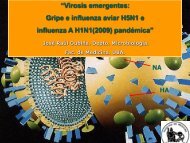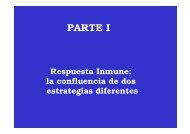Genes supresores del tumor
Genes supresores del tumor
Genes supresores del tumor
You also want an ePaper? Increase the reach of your titles
YUMPU automatically turns print PDFs into web optimized ePapers that Google loves.
<strong>Genes</strong> Supresores de Tumor<br />
Dra. María Marcela Barrio<br />
Centro Investigaciones Oncológicas – FUCA<br />
Maestría Biología Molecular Médica<br />
UBA - 2013
“Gatekeeper” genes<br />
• The “gatekeeper” gene monitor cell<br />
proliferation and death. They include:<br />
-”oncogenes” which are cell growth promoters,<br />
where dominant mutations lead to uncontrolled<br />
growth, and resistance to apoptosis.<br />
- “<strong>tumor</strong> suppressor” genes which are negative<br />
regulators of cell growth, where recessive<br />
mutation can lead to uncontrolled cell growth<br />
(e.g., p53).<br />
CIO-FUCA
“Caretaker” genes<br />
• The “caretaker” genes include genes that regulate<br />
DNA repair and chromosome segregation in mitosis.<br />
Mutation of these genes can cause abnormal<br />
“gatekeeper” function because of mutation or<br />
abnormal gene content. The “caretaker” genes<br />
include:<br />
- DNA repair genes, whose mutations lead to<br />
genetic instability (more mutations).<br />
- genes that regulate chromosome segregation,<br />
whose mutations lead to abnormal<br />
chromosome content, or chromosomal<br />
instability.<br />
CIO-FUCA
Tumor suppressor genes<br />
• First discovered in 1960s by Henry Harris.<br />
• Harris fused <strong>tumor</strong> cells with normal cells and discovered<br />
some of the hybrid cells were normal.<br />
• Harris hypothesized that the normal cells contained gene<br />
products that suppressed uncontrolled cell proliferation.<br />
• Some cancers show <strong>del</strong>etions of specific sites (<strong>tumor</strong><br />
repressor genes) that normally inhibit cell growth and<br />
division.<br />
e.g., breast cancer, colon cancer, lung cancer<br />
• Two mutations (one on each allele) are required to<br />
inactivate <strong>tumor</strong> suppressor genes.<br />
CIO-FUCA
Tumor suppressor genes<br />
Definition:<br />
1- its function is lost in the development of the<br />
<strong>tumor</strong><br />
2- its in vivo inactivation enhances initiation, growth,<br />
or progression of a <strong>tumor</strong><br />
CIO-FUCA
Tumor suppressor genes<br />
Properties of “classic” <strong>tumor</strong> suppressor genes<br />
1- They are recessive and undergo biallellic inactivation<br />
2- The inheritance of a single mutant allele accelerates <strong>tumor</strong><br />
susceptibility, because only one additional mutation is required<br />
for complete loss of gene<br />
3- The same gene is frequently inactivated in sporadic cancers
CIO-FUCA
CIO-FUCA
(Knudson's "two-hit" theory)<br />
A mutation in one of two copies (alleles) of an oncogene may be sufficient to<br />
cause the cell to lose growth control, both copies of a <strong>tumor</strong> suppressor<br />
gene must be knocked out to induce the same effect<br />
CIO-FUCA
Inactivation of Tumor Suppressor <strong>Genes</strong>.<br />
Classic <strong>tumor</strong> suppressor genes are inactivated via ‘two hits’. In the case of inherited<br />
cancer susceptibility, one of these ‘hits’ is acquired in the germline with the second<br />
‘hit’ being acquired somatically during <strong>tumor</strong> development.<br />
Haploinsufficient <strong>tumor</strong> suppressor genes are compromised by a single ‘hit’,<br />
obviating the need to sustain ‘two hits’ during the course of <strong>tumor</strong> development.<br />
CIO-FUCA
Tumor suppressor activitiy versus gene dosage<br />
Wild type (+/+) activity represents 100% of diploid gene function and true null (-/-)<br />
represents complete loss of functionality.<br />
Haploinsufficient <strong>tumor</strong> suppressors exhibit a continuum of activity based on gene<br />
dosage with even 50% reduction sufficient for phenotypic manifestation, i.e.<br />
accelerated <strong>tumor</strong>igenesis.<br />
While some genes may be less dosage-sensitive than others (in which a true threshold<br />
of close to 0% of normal gene product is required in order to detect a phenotype), we<br />
predict that most genes will be sensitive to dosage with some threshold that varies<br />
on a continuum between 0 and 100%.<br />
CIO-FUCA
CIO-FUCA
Factors Affecting Penetrance<br />
Modifier genes<br />
Carcinogens<br />
Response to DNA<br />
damage<br />
Hormonal/<br />
reproductive<br />
factors<br />
Not everyone with an altered gene develops cancer<br />
CIO-FUCA
Loss of Heterozygosity<br />
CIO-FUCA
Mechanisms of Tumor Suppression<br />
• Suppression of Cell Division<br />
Ej: retinoblastoma protein (Rb), adenomatosis polyposis coli (APC),<br />
alternate reading frame (ARF), RIZ1, p15, p16, p18, p19, p21, p27 and p53<br />
• Induction of Apoptosis<br />
Ej: p53, APC, cluster of differentiation 95 (CD95), bridging integrator<br />
1 (Bin1), Deleted in colorectal carcinoma (DCC) and phosphatase and tensin<br />
homolog (PTEN)<br />
• DNA Damage Repair<br />
Ej: mutS homolog 2 (MSH2), mutL homolog 1 (MLH1), Ataxia-telangiectasia<br />
Mutated gene product (ATM), breast cancer proteins (BRCA 1-2), Nijmegen<br />
breakage syndrome 1 (NBS1), Fanconi-Anemia−related <strong>tumor</strong> suppressor (FA)<br />
And p53<br />
• Inhibition of Metastasis<br />
Ej: metastin, breast cancer metastasis suppressor 1 (BRMS1), tissue inhibitor<br />
of metalloproteinase (TIMP), cofactor required for specificity protein 1<br />
activation (CRSP) and KAL1/CD82
CIO-FUCA
Mechanisms of Tumor Suppression<br />
Suppression of Cell Division<br />
is the main mechanism for most <strong>tumor</strong> suppressors (Rb, APC, ARF, RIZ1, p15,<br />
p16, p18, p19, p21, p27 and p53)
Retinoblastoma <strong>tumor</strong> suppressor gene<br />
(Rb)<br />
Mapped to gene chromosome 13q14 and sequenced.<br />
180 kb; codes a 4.7 kb mRNA that produces a 928 amino<br />
acid nuclear phosphoprotein, pRB.<br />
pRB is expressed in every tissue that has been examined<br />
and regulates the cell cycle.<br />
Retinoblastoma <strong>tumor</strong> cells possess point mutations or<br />
<strong>del</strong>etions in RB<br />
In hereditary retinoblastoma, second RB mutation often is<br />
identical to the inherited one (a possible example of gene<br />
conversion).<br />
CIO-FUCA
Retinoblastoma<br />
Rare malignant <strong>tumor</strong> arising from immature<br />
neurons in the retina<br />
About 40% of cases are associated with a<br />
germline mutation (60% are sporadic)<br />
5-10% of germline cases are inherited<br />
germline mutations<br />
20-30% are NEW germline<br />
mutations<br />
CIO-FUCA
Inherited germline Rb<br />
Affected child inherits one defective Rb allele,<br />
together with one normal gene<br />
If the remaining normal Rb allele is inactivated<br />
by <strong>del</strong>etion or mutation, the loss of its<br />
suppressor function leads to development of a<br />
retinoblastoma<br />
Thus, susceptibility to Retinoblastoma is<br />
inherited in a dominant fashion<br />
At the cell level TSG is recessive to show the<br />
phenotype<br />
CIO-FUCA
Sporadic retinoblastoma<br />
Child is homozygous for two normal Rb Alleles<br />
Both alleles must be inactivated in a retinal<br />
cell for disease to develop<br />
Sporadic disease is rare (1/30,000)<br />
CIO-FUCA
CIO-FUCA
CIO-FUCA
CIO-FUCA
Inhibidores de Cdk4 y Cdk6 (INK4)<br />
- p14, p15, p16, p18 bloquean actividad de las kinasas dependientes de<br />
ciclina D produciendo el arresto <strong>del</strong> ciclo celular en G1.<br />
Ciclina D<br />
P<br />
p16<br />
P<br />
RB1 o p107,<br />
p130<br />
RB<br />
Cdk4/6<br />
E2F<br />
p16<br />
Ciclina D<br />
RB<br />
transcripción<br />
Cdk4/6<br />
E2F<br />
DNA polimerasa , etc<br />
CIO-FUCA
CIO-FUCA
CIO-FUCA
Mechanisms of pRb inactivation in human cancer<br />
-Inactivation by deregulated pRb phosphorylation is common in a distinct subset of human<br />
cancers, but Rb1 mutation is rarely observed in this subset.<br />
- The mo<strong>del</strong> proposes that each mechanism of inactivation has different molecular and functional<br />
consequences.<br />
-Deregulated pocket protein phosphorylation is proposed to abrogate some protein interactions<br />
but not others.<br />
- Different cell types may select for different mechanisms of pRb inactivation because the molecular<br />
consequences are more favorable for Carcinogenesis.<br />
CIO-FUCA
CIO-FUCA
<strong>Genes</strong> <strong>supresores</strong> en <strong>tumor</strong>es humanos<br />
GEN Localización Cánceres asociados<br />
RB 13p14 Retinoblastoma, osteosarcoma, leucemias linfoides<br />
pulmón, mama ovario, próstata, vejiga.<br />
p53 17p13 Li-Fraumeni síndrome, mama, próstata, pulmón, colon,<br />
vejiga, hígado, linfomas/leucemias, cerebro, adrenal.<br />
WT1<br />
11p13-15 Tumor de Wilm's (cáncer renal infantil).<br />
NF-1 17q11.2 Neurofibromatosis, neurofibromas.<br />
NF-2 22q Meningioma, mama, colon.<br />
VHL 3p26 Células renales. Hemangioblastoma de cerebro.<br />
APC 5q21 Colon (FAP)<br />
MSH-2 2p16 Colon (HNPCC, proximal colon), endometrial, estómago.<br />
MLH-1 3p21.3-23 Páncreas, vejiga, ovario, mama.<br />
PMS 1 2q31-33<br />
PMS 2 7p22<br />
MTS1(p16) 9p21 Familial melanoma, glioblastoma,T-ALL, mesotelioma.<br />
MTS2(p15)<br />
NSCLC, vejiga.<br />
BRCA-1 17q21 Ca. de mama temprano, ovario, próstata, colon.<br />
BRCA-2 13q Ca. de mama temprano (Ca.de mama masc.) CIO-FUCA
P53 <strong>tumor</strong> suppressor<br />
gene
CIO-FUCA
CIO-FUCA
CIO-FUCA
CIO-FUCA
CIO-FUCA
CIO-FUCA
CIO-FUCA
CIO-FUCA
p53 <strong>tumor</strong> suppressor gene<br />
<br />
Mutations in p53 are implicated in ~50% of human cancers,<br />
including cancers of the:<br />
breast, brain, liver, lung,<br />
colorectal,bladder, and blood<br />
<br />
<br />
<br />
<br />
Development of <strong>tumor</strong>s requires mutations on two p53 alleles.<br />
Codes a 393 amino acid protein involved in transcription, cell cycle<br />
control, DNA repair, and apoptosis (programmed cell death).<br />
p53 binds to several genes, including WAF1, and interacts with at<br />
least 17 cellular and viral proteins.<br />
Transgenic mice with <strong>del</strong>etions of both p53 alleles are viable, but<br />
100% develop cancer by ten months of age.<br />
CIO-FUCA
CIO-FUCA
CIO-FUCA
CIO-FUCA
CIO-FUCA
CIO-FUCA
Algunos genes target de p53…<br />
-P21, GADD45: Se une a CDK2 inhibe fosforilación <strong>del</strong> RB arresto <strong>del</strong> ciclo celular<br />
-BAX, PUMA, NOXA: mitocondria liberan citocromo c activan caspasas – apoptosis<br />
P53AIP1<br />
-MDM2: ejerce loop feedback negativo autoregulatorio de p53 por ubiquitinación y<br />
degradación en el proteasoma de p53<br />
-P53R2: Induce el arresto en el checkpoint G2/M y participa en la reparación al daño <strong>del</strong><br />
DNA<br />
-Existen 4000 genes con sitios potenciales de regulación por p53<br />
-También p53 controla la transcripción de múltiples miRNA (miR-34, miR-192/215, miR-<br />
107) y de otros que actúan como <strong>supresores</strong> de <strong>tumor</strong>. Como resultante p53 puede<br />
controlar la progresión <strong>tumor</strong>al, invasión y metastasis, entre otras funciones.<br />
CIO-FUCA
Control de la estabilidad de p53<br />
y modificaciones post-traduccionales en p53<br />
- MDM2 ubiquitina el extremo COOH-ter para enviar a p53 al proteasoma<br />
para su degradación<br />
-MDM2 además impide la unión al DNA para la transcripción de genes target al unirse<br />
al dominio de trasactivación NH 2 -ter<br />
-MDM2 asistiría en el reclutamiento físico de p53 ubiquitinada hacia el proteasoma,<br />
contribuyendo a su degradación<br />
La inducción y activación de p53 en respuesta al stress está sujeta a regulación por<br />
Modificaciones post-traduccionales:<br />
- acetilación<br />
- sumoilación<br />
- fosforilación<br />
- o-glicosilación<br />
CIO-FUCA
DNA damage response<br />
DNA damage<br />
Sensor de daño al DNA<br />
γHistona H2AX fosforilada<br />
Nuclear foci cerca de lesiones DNA<br />
ATM<br />
P Ser-1981<br />
Activación check point ciclo celular<br />
RUNX3<br />
P Ser-15<br />
Arresto ciclo celular<br />
RUNX3<br />
p53<br />
Reclutamiento factores<br />
Tempranos de reparación<br />
Tardío en la reparación<br />
NFBD1 inhiben fosforilación de p53<br />
BAX<br />
PUMA<br />
Bloquea apoptosis<br />
NFBD1 t ATM fosforila p53<br />
Activa apoptosis<br />
Apoptosis<br />
CIO-FUCA
P53 como target terapéutico<br />
-P53 mutada debe ser reactivada y no inhibida como otros targets mutados<br />
(oncogenes)<br />
-Múltiples mutaciones lo convierten en un target estructural heterogéneo<br />
CP-31398 re-pliega p53 mutante dandole estabilidad conformacional activa,<br />
restaurando el fenotipo wild type<br />
PhiKan083 se diseñó por moldeado molecular para unirse a residuos críticos<br />
que confieren estabilidad conformacional activa a p53 mutada<br />
PRIMA-1 es un compuesto que restaura la conformación wild type de p53 mutante<br />
e inhibe el crecimiento de muchas líneas <strong>tumor</strong>ales en forma dependiente de p53.<br />
(in vitro e in vivo)<br />
Se están realizando ensayos clínicos con PRIMA-1 en ptes con ca. próstata y<br />
cánceres hematológicos- Se vio respuesta clínica en pts con p53 mutado<br />
CIO-FUCA
P53 como target terapéutico<br />
CIO-FUCA
Adenomatous polyposis coli<br />
(APC)<br />
Tumor suppressor gene<br />
First characterized because of its association<br />
with familial adenomatous polyposis<br />
Further study proved its role in sporadic cases<br />
of colon cancer<br />
CIO-FUCA
Familial adenomatous polyposis<br />
An autosomal dominant disease<br />
Occurs in 1 in 10,000 individuals in U.S.<br />
Accounts for 10% of colorectal cancer<br />
APC gene function is lost or defective<br />
CIO-FUCA
APC gene product<br />
Cytoplasmic protein<br />
Interacts with and promotes<br />
degradation of Beta-catenin<br />
(transcriptional activator of growth<br />
promoting genes – Wnt pathway)<br />
Loss of APC = up-regulation of cell<br />
proliferation<br />
CIO-FUCA
APC<br />
Targets of TCF: c-myc, cyclin D1 (cell proliferation)
BRCA 1 Y BRCA 2<br />
CANCER DE MAMA Y OVARIO<br />
CIO-FUCA
Breast Cancer Tumor Suppressors<br />
Breast cancer affects 1 in 10 women and represents 31% of<br />
cancers in women (~215,990 women diagnosed each year,<br />
2004 estimate).<br />
~5-10% of breast cancers are hereditary; age of onset for<br />
hereditary breast cancer is earlier than other forms<br />
(mutations at 2 alleles).<br />
A small proportion of breast cancer is heritable. Two<br />
genes are associated with predisposition to developing<br />
breast cancer.<br />
- BRCA1 on chromosome 17<br />
- BRCA2 on chromosome 13<br />
Normal function of both is in repair of ds DNA breaks.<br />
CIO-FUCA
BRCA 1<br />
A <strong>tumor</strong> suppressor gene for breast and<br />
ovarian cancer<br />
Localized on chromosome 17q21<br />
Approximately 5-15% of breast Ca is inherited<br />
- 85% is sporadic<br />
BRCA1 is responsible for approximately HALF<br />
of the INHERITED breast cancers<br />
CIO-FUCA
BRCA 2<br />
Chromosome 13q12-13<br />
Germline mutations in BRCA2 gene increase<br />
risk of breast (male and female) and ovarian<br />
cancer<br />
CIO-FUCA
CANCER DE MAMA HERED.<br />
• ANÁLISIS: 237 FAMILIAS<br />
• BRCA 1: 52 %<br />
• BRCA 2: 32 %<br />
• INDETERM.: 16 %<br />
• Familias con:<br />
• Ca. mama y ov.: BRCA1 >> BRCA2<br />
• Ca. mama fem.y masc. BRCA2>>BRCA1<br />
Ford et al.Am.J.Hum.Genet.62, 676, 1998
CIO-FUCA
CIO-FUCA
CIO-FUCA
Dominios de BRCA1<br />
N-ter Ring domain:<br />
E3 ubiquitin ligase activity and facilitates protein ubiquitination<br />
C-ter BRCT domain:<br />
Phospho-protein binding domain, required for BRCA1 translocation<br />
and accumulation at DNA damage sites<br />
BRCA1 is a key player in the DNA damage response<br />
BRCA1 relocates to DNA damage sites and form nuclear loci<br />
following DNA double- strand breaks
ESTRUCTURA Y FUNCION DE<br />
BRCA 1<br />
• Fosfoproteína nuclear de 220 kDa en<br />
células normales.<br />
• Los niveles de mRNA de BRCA1<br />
disminuyen con la transición CIS a<br />
carcinoma invasor.<br />
• Como BRCA1 y RAD51, BRCA2 relocaliza<br />
a sitios de replicación en fase S luego de<br />
exposición a OH-urea ó luz UV.<br />
• INTERVIENE EN LA REPARACION DEL<br />
DNA<br />
CIO-FUCA
CIO-FUCA
CIO-FUCA
BRCA1 in DNA damage-induced cell cycle<br />
checkpoints activation<br />
G1/S checkpoint:<br />
p53, control via p21<br />
BRCA1 facilitates p53 phosphorylation by ATM<br />
S-phase checkpoint:<br />
ATM and ATR via Chk1 and 2 regulate cyclins and cyclin-dependent kinases<br />
activity during S phase<br />
BRCA1 participates in this signal transduction by regulating Chk1 kinase and<br />
phosphorylation of BRCA1 is required for the S-phase checkpoint following irradiation<br />
Suggesting phospho-BRCA1 may recruit functional partners for regulating this signal<br />
Cascade.<br />
Additionally BRCA1 may also regulate ATM phosphorylation after DNA damage<br />
in S phase.
G2/M checkpoint:<br />
ATM and ATR phosphorylates Chk1 and 2<br />
Phosphorylate mitotic kinase<br />
Weel and complex Cdc25A/B/C<br />
This suppresses the activuty of cyclin B abd Cdc and blocks mitosis<br />
Loss of BRCA1 abolishes G2/M checkpoint;<br />
Like in S-phase checkpoint , BRCA1 regulates Chk1 kinase activity during<br />
G2/M checkpoint.<br />
ATM phosphorylates BRCA1 in a different position than in S-phase checkpoint,<br />
Implicating that BRCA1 may have different functional partners in G2/M checkpoint
BRCA1<br />
-BRCA1 activa los 3 check points <strong>del</strong> ciclo celular (G1/S, S y G2/M) a través de distintas<br />
fosforilaciones que le confieren funciones reguladoras distintas<br />
-Interacciona con p53 facilitando la fosforilación de p53 por ATM en respuesta al daño<br />
1) P53 –P<br />
P21 WAF1<br />
Arresto en G1/S<br />
2) BRCA1 detiene la replicación <strong>del</strong> DNA (mecanismo desconocido)<br />
3) Detiene la mitosis para permitir reparación <strong>del</strong> DNA regulando la actividad de<br />
ChK1 quinasa<br />
CIO-FUCA
CIO-FUCA
Tumor suppressor genes<br />
Gene<br />
BRCA1<br />
BRCA2<br />
TP53<br />
PTEN<br />
CHK2<br />
Undiscovered genes<br />
Contribution to<br />
Hereditary Breast Cancer<br />
20%–40%<br />
10%–30%<br />
PTEN Tumor suppressor gene<br />
- Mapea en cromosoma 10q23<br />
- Es fundamental para el desarrollo embrionario<br />
- Está mutado y <strong>del</strong>ecionado en múltiples cánceres (mama, pulmón) y<br />
desórdenes linfoproliferativos letales<br />
- Presenta haploinsuficiencia (no todos los <strong>tumor</strong>es pierden el alelo normal)<br />
-Pérdida de PTEN en línea germinal genera sindromes hereditarios (PHTS):<br />
múltiples Hamartomas<br />
Alta susceptibilidad al cáncer<br />
Desórdenes neurológicos<br />
-Biopsias de cánceres esporádicos tienen menor expresión de PTEN pero<br />
el segundo alelo no está mutado<br />
CIO-FUCA
PTEN Tumor suppressor gene<br />
Función:<br />
1- Fostasa de lípidos: defosforila PIP3 (3’ fosfoinosítido-3,4,5 trifosfato)<br />
PIP3 activa la vía PI3K proliferación celular- inhibición apoptosis<br />
PTEN es un regulador negativo de vía PI3K<br />
2- Actividad supresora <strong>tumor</strong>al nuclear directa sin actividad fosfatasa:<br />
- regula inestabilidad genómica<br />
- Progresión en el ciclo celular<br />
- diferenciación celular<br />
- expresión génica<br />
CIO-FUCA
PTEN
PTEN Tumor suppressor gene<br />
Ratones heterocigotas (penetrancia incompleta) desarrollan ca. próstata intraepitelial<br />
e in situ<br />
Ratones con fenotipo hypo/-, presentan reducción de proteína PTEN de 70-80% y<br />
forman <strong>tumor</strong>es de próstata con 100% penetrancia, invasivos y metastásicos<br />
Ratones hyper/+ , presentan reducción de proteína PTEN <strong>del</strong> 20% y forman <strong>tumor</strong>es<br />
de mama, ganglios linfáticos, pulmón. No poseen mutación en el alelo wt.<br />
Existe una exquisita sensibilidad tejido específica a la disminución de los<br />
niveles de PTEN con tejidos muy poco sensibles (próstata) y otros muy<br />
sensibles (mama y ganglio)<br />
Haploinsuficiencia convierte a PTEN en TSG<br />
(ca. mama, reducción <strong>del</strong> 35%, asociados a signature génica ; reducción <strong>del</strong> 15 % en sanas,<br />
predisposición?)<br />
CIO-FUCA
PTEN Tumor suppressor gene<br />
¿Qué factores pueden disminuir los niveles de PTEN?<br />
- factores <strong>del</strong> ambiente (dieta, zinc, drogas)<br />
- eventos genéticos (mutaciones, <strong>del</strong>eciones)<br />
- Control transcripcional de PTEN por vía de MAPK y c-Jun (ras<br />
mutado resulta en reducción de PTEN)<br />
- Control post-transcripcional (miRNA, pérdida de ceRNA<br />
(competitivo endógeno)<br />
- Control post-traduccional (drogas, E3-ligasas, enzimas<br />
deubiquitinantes, DUB)<br />
CIO-FUCA
PTEN<br />
Figure 1. Impact of PTEN regulatory cues in <strong>tumor</strong>igenesis. Schematic of the tissue-specific cancer sensitivity to PTEN downregulation and the<br />
regulatory factors that could lead to the reduction of PTEN levels. PTEN expression is regulated at multiple levels, genomic (mutation and <strong>del</strong>etions),<br />
transcriptional (transcription factors), post-transcriptional (miRNAs, ceRNAs, such as the PTEN pseudogene), and post-translational [drugs, E3-ligases,<br />
deubiquitinating enzymes (DUB)]. In turn, the reduction of PTEN levels has a gradual and tissue-specific impact on cancer initiation in the mouse, with the<br />
mammary tissue being among the most sensitive tissues to PTEN level reduction. These data suggest that, in humans, subtle reduction of PTEN levels may<br />
lead to cancer susceptibility, cooperate with other oncogenic events in cancer progression, or affect the response to therapy.<br />
CIO-FUCA
Control epigenético de la supresión <strong>tumor</strong>al<br />
-Modificaciones epigenéticas son cambios heredables en la<br />
expresión génica que ocurren sin alterar la secuencia de DNA<br />
(ej: metilación <strong>del</strong> DNA y modificaciones en las histonas)<br />
- Metilación <strong>del</strong> DNA : 1- preserva la integridad <strong>del</strong> DNA<br />
2-silenciamiento de genes a nivel transcripcional<br />
- CpG son targets de metilación (CpG islands en promotores,<br />
DNA repetitivo, regiones pericentroméricas, y non-CpG islands)<br />
-Metilación en promotores y cuerpo de los genes tiene función<br />
regulatoria<br />
- Metilación fisiológica para imprinting de genes e inactivación<br />
de X en hembras<br />
CIO-FUCA
Control epigenético de la supresión <strong>tumor</strong>al<br />
-Maquinaria metilante fisiológica está regulada por el ciclo celular para mantener<br />
la metilación y preservar los patrones durante la replicación<br />
- En <strong>tumor</strong>es todo lo contrario: existe deregulación de la maquinaria demetilante<br />
y una gradual de-metilación <strong>del</strong> genoma así como la adquisición de hipermetilación<br />
aberrante en CpG islands ( puede reprimir TSG).<br />
- Hipometilación puede activar oncogenes<br />
- Hipoacetilación de histonas también resultar en silenciamiento transcripcional<br />
de TSG ; también fosforilación, sumoilación, ubiquitinación, biotinilación, etc)<br />
- Hipermetilación de promotores interfiere con la unión de factores de transcripción<br />
o alterando la cromatina, existiendo cooperatividad con la marcas de histonas<br />
acetiladas<br />
-Se pueden usar como target, tratamiento con agentes de-metilantes o inhibidores<br />
de la HDAC para re-expresar los genes.<br />
(ej: 5-azadC, tricostatina)<br />
CIO-FUCA
CIO-FUCA
Cancers Usually Result from a Series<br />
of Mutations in a Single Cell<br />
Tumor suppressor<br />
oncogene<br />
Tumor suppressors<br />
Normal -> proliferating -> benign -> intermed. -> late -> cancerous -> colon<br />
epithelium adenoma adenoma adenoma adenoma cancer<br />
with villi<br />
CIO-FUCA
Bert<br />
Vogelstein’s<br />
mo<strong>del</strong> of<br />
colorectal<br />
cancer<br />
OMIM-175100<br />
CIO-FUCA



